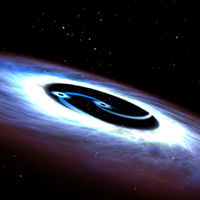Quasars are the light fantastic. These brilliant cores of active galaxies blaze with the radiance of a hundred billion stars compressed into a region of space not much larger than our solar system. Supermassive black holes, with millions or billions of times the mass of our sun, are the only imaginable powerhouse behind these tsunamis of raw energy.

Hubble Space Telescope astronomers set their sights on the nearest quasar to Earth, Markarian 231, located 581 million light-years away. Black holes — even supermassive ones — are too compact to be resolved by any present-day telescope. So, astronomers did the next best thing, measure all the light from a disk of infalling material around the black hole. The ultraviolet radiation — only measurable by Hubble — revealed evidence for a curious gap in the disk. Instead of being pancake shaped, it looks more like it has a big donut hole. The best explanation for the gap is that two black holes are orbiting each other in a dizzying dance that powers the quasar fireworks. This carves out the gap. The second black hole must have come from a smaller galaxy that merged with Markarian 231 to ignite the quasar about 1 million years ago.
For more information about this study,visit the story at
http://hubblesite.org/newscenter/archive/releases/2015/31/
